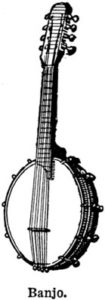Banjos come of different materials, construction, tunings, and string configurations. You will find other banjos better suited for some styles and genres in the market than others.
Herein you will learn more about this musical instrument and, more especially, its general construction.
Table of Contents
The Body
Generally, the body of this instrument is made up of wooden rim and rare cases you will find it made up of metal, the skin, and a metal tone ring. The banjo skin is similar to a drum head in nature.
Depending on the model and make of the banjo, you will find others having an open back while others with an added metal resonator plate at its back.
Resonator and Open Back
Banjos have a resonator or just an open back. It is the component that contributes much to the type of sound produced by the banjo.
Days back, the head would be constructed using the skin; however, this has remained the thing of the past. In this modern era, it’s built by synthetics similar to what is employed in the drumheads.
By changing the banjo head, you would have changed its sound also. For the resonator banjo, it has a Mylar head with frosting to produce bluegrass sound. However, for the open back types, manufacturers have employed different construction materials trying to tailor-produced sound.
Banjos look simple in the design on their surface. However, there is a lot more to their general design than what we see out on their surfaces.
They have an intricate design consisting of different parts at large. The overall construction of the instrument can be pulled from two main parts. This is its pot assembly and the neck.
Each of these parts has several components to give the instrument its unique design. Let’s look at different parts of the banjo and try to understand more what they are made of.
The Neck
The neck connects the head of the banjo to the body, and this is where the frets are mounted. The banjo neck is made of wood.
Once strings are pressed down, it’s the frets to dictate the type of note that will be produced.
The Head
The tuners of the banjo are located at the head of the banjo. The head itself is situated on the opposite side towards the end of the body.
The head is generally made up of wood material. Tuners are made of plastic, and they are used to hold in place the strings and make adjustments to the tuning of strings when turned.
Skin
This is located on the front side of the banjo body. The skin used initially was from dried animal skin. However, as things have advanced, the skin is today made from synthetic materials like, for instance, plastic.
The Strings
The banjo is set up using four or five different strings. These strings can be tuned to different open chords; this depends on the style of playing music.
Strings used on the banjo are similar to those for the guitars, and they are typically made of steel.
The basics of a banjo
The body of a banjo is everything that makes this instrument a special one in the music industry.
Or to be more precise, a combination of the banjo’s hollow rim covered with its head or membrane is everything that creates the best sound heard from the instrument.
The banjo can be technically used to describe all existing musical stringed instruments with its construction that was brought by the Africans to the Americans.
At the wood rim, there is a mounted head with a tone rim made of metal. Brass is usually used in this case, and the ring is bolted with a tension hoop.
Conclusion
Understanding the intricacies of what makes the banjo make sound and what type of materials go into producing that beautiful sound will serve you well when learning this great instrument.
Of course banjos vary in the type of wood, strings, body and overall style. They are made pretty much the same way with the same materials. This article explains how much a banjo costs.
If you’re wondering how to make a banjo from scratch then you can watch this video that gives you a visual and instructions to a DIY banjo.
Continue leaning about the banjo and have a great day!



